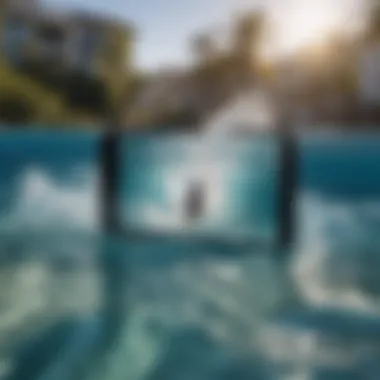Understanding Pool Wave Makers: Functionality and Benefits


Intro
Pool wave makers are becoming a staple in modern aquatic facilities, redefining the dynamics of water play and competitive training. Whether in the context of a leisure swimming pool or a training venue for budding athletes, the functionality and impact of these devices cannot be understated. They generate waves which not only mimic oceanic experiences but also present unique challenges and opportunities for users. As we navigate through the discussion, we will explore the core mechanics involved in wave production, the inherent benefits they offer, as well as potential drawbacks.
Techniques and Skills
In engaging with pool wave makers, both beginners and seasoned enthusiasts can find avenues to enhance their water experience. Knowledge of fundamental techniques is essential for any novice taking the plunge into aquatic activities driven by wave technology.
Essential Techniques for Beginners
For those new to the experience, starting with basic skills helps foster confidence and safety in the water. Here, a few key techniques come into play:
- Understanding the Equipment: Familiarize yourself with the pool and wave maker settings. Knowing how to operate the controls ensures smooth transitions and enhanced sailing on waves.
- Body Positioning: Learning to maintain an optimal body position while riding or swimming through waves can affect speed and maneuverability. Keeping a low center of gravity aids in stability.
- Breathing Techniques: Proper breath control can be the difference between an enjoyable experience and one filled with anxiety. Practice timed breathing to help with wave riding and underwater navigation.
Advanced Skills for Experienced Watersport Enthusiasts
For those on a quest for mastery, honing advanced skills can elevate the overall aquatic experience. Namely:
- Wave Riding Strategies: Beyond paddling, understanding the nuances of wave patterns can enhance performance. Anticipating wave formation allows for better preparation and tactical positioning.
- Trick Execution: From flips to spins, executing tricks on a surfboard or bodyboard amidst waves offers thrill. Practicing in a controlled environment allows athletes to branch out.
- Competing in Currents: Competitive training utilizing wave makers enables users to simulate real-world surf conditions. Mastering these currents can support athletes in preparing for actual competitions.
Equipment and Gear
Picking the right equipment is crucial when gearing up for wave-based activities. The quality and type of gear can influence both safety and performance.
Must-Have Gear for Each Watersport
When immersing oneself in the world of wave making, having the right equipment is non-negotiable:
- Surfboards and Bodyboards: Selecting appropriate boards that suit one's skill level and the type of waves produced is key. Beginners might benefit from more buoyant boards while advanced users may opt for performance boards.
- Wetsuits: Depending on the temperature of the water, a good wetsuit can be invaluable. It maintains body heat while providing protection against abrasions and irritants.
- Safety Gear: Helmets and impact vests should be considered for protection, especially during more daring maneuvers.
Tips for Selecting the Right Equipment
- Research and Reviews: Dive into reviews across forums like Reddit or product comparisons on sites such as Britannica.com. User feedback can provide insights on durability and performance that sometimes eludes specifications.
- Test Before You Buy: If possible, get hands-on experience with gear prior to purchase. Testing different brands and types allows individuals to find the fit that works best.
- Consider Long-Term Use: Investing in quality equipment that can grow with the user prevents the need for frequent replacements, ultimately saving money and frustration.
"Understanding the intricate dynamics of pool wave makers can enhance not just the enjoyment but also the safety of any watersport activity."
As we delve further into the mechanics and future advancements in the realm of pool wave makers, we continue to uncover how these technologies shape the aquatic world.
Preface to Pool Wave Makers
In recent years, the pool industry has witnessed a surge in interest regarding wave-making technology. This section aims to shed light on the significance of pool wave makers and their transformative impact on aquatic experiences, whether for leisure, fitness, or professional training. Understanding the nuances of these devices is essential for anyone involved in pool management or anyone with a vested interest in water sports and recreation.
When we talk about pool wave makers, we're discussing more than mere machinery; we dive into a world of possibilities that enhance user engagement and create dynamic aquatic environments. Pool wave makers facilitate a range of activities, from leisurely swimming to rigorous training for water sports, making pools more versatile and appealing.
Importance of Pool Wave Makers
The introduction of wave makers in pools enhances the recreational experience manifold. Imagine a family enjoying a sunny day at a pool that simulates ocean waves, or athletes training in a controlled environment that mimics sea conditions. The versatility of these devices cannot be overstated—they bridge the gap between natural bodies of water and artificial pools, making water activities more accessible and enjoyable.
However, the benefits don't stop at enjoyment. Instructors and coaches can leverage controlled wave settings for training purposes, allowing them to simulate competitive environments or specific water conditions. This functionality turns ordinary pool setups into sophisticated training grounds.
Additionally, considerations about installation, cost, and maintenance must be addressed. Pool owners and managers should be informed about the space requirements and financial implications before choosing to implement wave-making technology.
"The introduction of wave-making technology redefines what a pool can offer—it's no longer just a place to swim, but a venue for endless aquatic adventures."
The evolution of this technology and its various facets will be explored in the following subsections, thus laying a solid groundwork for understanding the full impact of pool wave makers.
Understanding Wave Makers
Wave makers work by generating waves that create a natural swimming environment. Their design typically includes mechanisms that push water outward, forming waves that roll back into the pool. Different technologies govern how these waves are created, ranging from mechanical systems to hydraulic solutions. Understanding the underlying technology is key for optimizing functionality and achieving desired effects.
Origins and Evolution of Wave Technology
The concept of wave-making technology has roots that go back several decades, with earlier versions resembling mechanical systems designed purely for entertainment. Over time, advancements in engineering and materials science have transformed these rudimentary wave makers into complex machines capable of replicating a range of water conditions.
In recent years, wave technology has adapted significantly—including the integration of smart technology and user-friendly interfaces that allow for customizable experiences. Innovations like hydraulic and air-driven systems have broadened the scope of how waves can be generated, impacting pool design and functionality immensely.


With a keen understanding of both the historical context and technological advancements, we can better appreciate the present and future of wave-making technology in transforming aquatic environments.
Mechanics of Wave Creation
Understanding the mechanics behind wave creation is essential for grasping the functionality of pool wave makers. The sophistication of these devices can profoundly affect the user experience. When implemented correctly, they can elevate recreational swimming to exhilarating levels, offering experiences typically reserved for major water parks or natural settings. Consequently, the success of an aquatic facility often hinges on how well it integrates these technologies and what users expect from their time in the water.
How Pool Wave Makers Function
Pool wave makers generate waves through various methods that mimic natural ocean waves. Typically, they utilize either mechanical movements, jets of water, or air being forced through the water. The mechanical devices use large paddles or blades to push water back and create swells. Each system is designed to produce distinct wave patterns, catering to different swimming experiences.
The unique aspect of these systems is their ability to adapt to varying depths and pool sizes, ensuring a tailored experience for users. This adaptability has made them effective for both leisure and training environments, shaping the way individuals engage with water.
Components of a Wave Maker
A pool wave maker isn't just a simple gadget, but a complex assembly of parts working in harmony. Here are the main components:
Motors
The motors are the heartbeat of the wave maker, propelling the entire system into action. Powerful and reliable, these motors generate the necessary force to create waves by driving the paddles or blades.
One significant characteristic of these motors is their energy efficiency. Advanced designs often account for both performance and power consumption, making them a popular choice for facilities looking to minimize operational costs. However, while they are robust, these motors can also introduce some level of noise, which may affect the overall user experience.
Blades
The blades play a crucial role in shaping the waves produced. Typically, they are designed to slice through the water's surface, creating ripples that swell into larger waves.
A key characteristic of swimming pool blades is their hydrodynamic shape. This design not only enhances wave formation but also helps with energy use efficiency. Yet, the material choice for blades can impact their longevity and performance. Plastic is common, but metals might be favored in more popular settings due to their durability.
Control Systems
Control systems manage the operation of wave makers, providing users with the ability to customize wave height, frequency, and direction. With the rise of smart technology, modern wave makers often integrate automated systems that respond to user preferences in real-time.
A standout feature of these control systems is their user-friendly interface, making it easier for pool managers to make adjustments on-the-fly. However, reliance on technology can sometimes lead to unforeseen issues, like system failures, which could impact wave production and, ultimately, user satisfaction.
Types of Wave Makers
The innovation in wave-making technology has led to the development of various types of wave makers, each catering to different needs and preferences:
Mechanical Wave Makers
Mechanical wave makers use large paddles to displace water. Their design allows for impressive wave generation without relying heavily on technology. One prominent characteristic of these devices is their simplicity. This often translates into fewer maintenance challenges, making them suitable for public pools where reliability is essential.
The distinctive feature of mechanical wave makers is that they can generate powerful, consistent waves ideal for surfing practice. However, they might have limitations in producing varied wave types, which can be restrictive for diverse aquatic activities.
Hydraulic Wave Makers
Hydraulic models use pressurized water to create waves. They're particularly noted for their dynamic wave patterns, allowing a range of shapes and sizes that can cater to different user preferences.
These devices often gain favor for larger facilities that can handle the associated plumbing and water management systems. The hydraulic nature means they can create more complex waves, yet it comes at the cost of higher maintenance and setup complexity.
Air-Driven Wave Makers
Air-driven wave makers utilize air jets to produce waves, making them versatile and efficient in smaller pools. These systems are characterized by their ability to produce waves with minimal physical infrastructure.
Their unique modular design allows for easy adjustments, enabling operators to fine-tune for recreational or training purposes. Yet, the reliance on air can impact the consistency of wave generation, which might not satisfy all users.
"A well-designed wave maker can turn an average pool day into an unforgettable aquatic adventure."
Through detailed understanding of these mechanics, users can appreciate the depth of experience offered by wave makers, crafting engaging aquatic environments that draw in crowds and foster excitement.
Benefits of Pool Wave Makers
Pool wave makers offer a variety of advantages that go beyond just creating waves; they transform the aquatic experience. This particular section outlines how these systems serve recreational purposes, support athletes in training, and contribute to a lively atmosphere, thus appealing to a diverse audience from leisure seekers to competitive swimmers.
Enhancing Recreational Experiences
Pool wave makers significantly enrich the enjoyment of water activities. Imagine visiting a water park without the rushing waves – it would hardly feel like a day of fun. The ripple effects they produce allow families and friends to engage in activities like bodyboarding or even surfing in a controlled environment.


A study conducted showed that pools with wave makers see greater user satisfaction, often translating into loyal customers who return frequently. An important aspect here is how these systems cater to families, providing safe yet thrilling experiences for all ages. Different wave settings can mimic ocean swells, allowing users to tailor their experiences to their comfort levels while enjoying dynamic water maneuvers.
Facilitating Training for Water Sports
For athletes, particularly those focused on aquatic sports, wave makers are invaluable tools used to refine skills. Different wave patterns provide athletes with training conditions mirroring those found in oceans or lakes. This controlled setting reduces risk for injuries and ensures that athletes can repeat specific drills that are crucial to their development.
Professionals like surfers and swimmers can benefit immensely; they can practice techniques, balance, and endurance, honing their skills without the usual unpredictability of natural waves. Coaches can assess performances better, making adjustments quickly as they analyze individual techniques. Moreover, it’s not just for the pros; aspiring athletes can improve confidence and techniques, making it easier to transition into competitive environments.
Creating Dynamic Pool Environments
The presence of waves transforms the overall ambiance within a pool setting. A flat body of water is quite passive and doesn’t entice much excitement. In contrast, a wave-filled pool becomes a dynamic environment, encouraging people to engage actively. This electrical atmosphere promotes social interaction, fitness, and a sense of community.
Here’s a quick breakdown of some benefits that dynamic environments provide:
- Increased Engagement: Users are more likely to spend extended time in a thrilling, animated space.
- Enhanced Fitness Opportunities: Sessions can be designed to include water aerobics or even dance classes utilizing wave movement, drawing in fitness enthusiasts.
- Event Versatility: From pool parties to competitive events, wave pools can host a wide range of activities that draw crowds.
In essence, pools equipped with wave makers create an all-encompassing space that encourages fun, fitness, and community engagement.
In summary, the benefits of pool wave makers are manifold. Not only do they enhance recreational enjoyment for casual visitors, but they also serve crucial roles in athletic training while fostering lively, dynamic environments conducive to social interaction.
Considerations for Installation
When it comes to installing a pool wave maker, there are a few critical points to weigh. Proper installation not only ensures optimal functionality of the wave maker but also enhances the overall pool experience. Before diving in, one must consider space requirements, costs associated with installation and maintenance, as well as the operational demands unique to each wave maker.
Space and Design Requirements
The spatial footprint and design layout of a pool facility play a significant role in the successful installation of wave makers. It's not just about the size of the pool; the shape and depth matter too. A rectangular pool generally accommodates wave makers more effectively than a free-form shaped pool. Here are some key considerations:
- Area for Equipment: Wave makers often require dedicated space for their operational equipment. This includes motors and control systems, which need to be accessible for maintenance.
- Water Depth: The depth of the pool needs to be compatible with the type of wave maker. For example, larger hydraulic systems may require deeper water to generate waves effectively.
- Deck Area: Sufficient deck space is essential for users to safely enter and exit the pool as waves are produced. A cramped deck can pose safety hazards, and it also detracts from the enjoyment factor.
A thoughtful layout can make or break the user experience. As such, it's wise to engage with a design professional early in the planning stage to assess not just spatial considerations, but how it can flow aesthetically as well.
Cost Analysis
Financing a wave making system involves a multidimensional approach. Initially, there may be sticker shock when one reviews the costs associated with both the purchase and installation of these systems. However, understanding that this is an investment can shift perspective. Here are some pertinent points to consider:
- Initial Purchase: The cost of different wave makers varies widely based on technology and capacity. Mechanical systems tend to be less expensive compared to hydraulic options. On average, one might expect to spend anywhere from $10,000 to $100,000, contingent upon features.
- Installation Expenses: Engagement with contractors and electrical specialists can also be a significant add-on. Depending on the project, contractor fees vary, which means budgeting for at least 20% on top of equipment costs may be prudent.
- Long-term Investment: Analyzing ongoing costs, including energy consumption and the potential for attracting more users, can position wave makers as advantageous financially over time. The goal is to maximize return on investment through increased membership and varied offerings.
Maintenance and Operational Costs
Maintenance of pool wave makers is crucial for longevity and optimal operation. Skimping on upkeep can lead to costly repairs down the line. Regular service checks and operational costs are components of the overall budgeting process. Consider the following aspects:
- Routine Maintenance: Regular inspections and maintenance are necessary to keep the machinery running smoothly. This includes periodic checks on motors, blades, and control systems. Setting aside funds for annual inspections is a smart move.
- Energy Costs: Wave makers consume energy during operation. Understanding the energy footprint will help manage and predict long-term operational costs. Investing in energy-efficient models can mitigate some ongoing expenses, yielding some savings in the long run.
- Replacement Parts: Like any mechanical system, parts will eventually wear out over time. Having a budget for replacements will ensure uninterrupted operation. It's worth noting that some parts might not be readily available, which can delay repairs.
In sum, thinking through installation requirements is not merely a technical exercise, but an engaging opportunity to enhance overall aquatic experiences. Proper planning and budgeting can drastically improve both functionality and enjoyment of wave-making technology.
Overall, the installation of pool wave makers is not a straightforward endeavor. With the right planning, the potential benefits can be extensively rewarding, creating dynamic experiences for users and potentially transforming your pool into an attractive destination.
Potential Drawbacks of Pool Wave Makers
While pool wave makers offer a multitude of benefits, it is crucial to address their potential drawbacks to provide a balanced view. Examining these concerns helps pool designers, users, and investors make informed decisions before integrating this technology into aquatic settings. This section uncovers the nuances surrounding safety issues, environmental implications, and possible user experience challenges.
Safety Concerns
Safety is paramount in any swimming environment, and pool wave makers present unique risks. The dynamic movement of water generated by these machines can lead to unexpected outcomes. For instance, individuals, especially children, might struggle with navigating stronger currents or rapid wave motion. There's also the chance of accidents involving slips or falls as swimmers react to suddenly changing aquatic conditions.
Adding to this, some wave makers operate with mechanical components that may present maintenance challenges. Any malfunction can potentially result in safety hazards. Regular inspections and maintenance routines are essential to minimize these risks. Operators need to ensure that safety measures, such as lifeguards or clear warning systems, are implemented to safeguard users.
Environmental Impact
Next, we need to talk about how these wave-making technologies impact the environment. On one hand, they create recreational benefits, but they can also disrupt natural ecosystems when installed in outdoor settings. Water circulation can alter local habitats, affecting flora and fauna. Moreover, the energy consumption associated with pool wave makers raises questions about sustainability.
To mitigate these impacts, pool owners can look into energy-efficient models or integrate renewable energy sources to power wave makers. This transition to greener technologies not only lessens the carbon footprint but also aligns recreational facilities with modern eco-conscious practices. For instance, solar panels could be utilized to harness energy during sunny periods, potentially powering these wave systems at lower costs.
User Experience Challenges
User experience is another area that warrants attention. While many individuals crave the exciting waves created by these machines, not everyone may find them enjoyable. Beginners or the less adventurous may feel apprehensive, leading to anxiety in water. This can affect their overall enjoyment and willingness to use the facility. For instance, a novice swimmer could feel overwhelmed trying to keep afloat amidst artificial waves.


Moreover, varying preferences among users can lead to divided opinions regarding wave intensity. Regular users might enjoy strong waves, while others prefer calmer waters. Pool managers need to consider guest demographics when adjusting wave settings to suit a broader audience. Maintaining a balance to cater to both thrill-seekers and leisure swimmers is paramount for a successful operational model.
It’s clear that while pool wave makers can enhance user enjoyment, they also introduce certain drawbacks requiring careful consideration and management.
Future Developments in Wave Making Technology
As we move forward in the realm of pool wave makers, it’s essential to spotlight developments that hold promise for improving both functionality and user experience. Innovations in wave-making technology get brainstormed quite a lot, and the focus is on how these enhancements can not only cater to current users but also attract a broader pool of enthusiasts.
Innovations in Design
The push for creativity in the design of wave makers is exhilarating. Designers are tapping into advanced materials and smart technology to optimize performance. For instance, incorporating aerodynamics into the design of wave blades can create waves that are more consistent and enjoyable. Additionally, using modular components allows pool operators to modify their systems based on user demographics or seasonal requirements. This flexibility can lead to significant improvements in operational efficiency.
For instance, a wave maker that features adjustable settings can tailor wave height and frequency according to user preference— a significant leap from standard offerings. That means family fun time can range from gentle ripples for kids to more vigorous swells for thrill-seekers. A wave system that adapts to its users not only attracts a more diverse crowd but also enhances the overall enjoyment.
Integration with Other Aquatic Features
Next up, the harmony that can exist between wave makers and other aquatic installations should not be overlooked. Integrated systems that combine wave making with water slides or splash zones present unique opportunities. Imagine a scenario where the wave generator syncs perfectly with an adjacent slide. As one user slides down, they’re met with a wave puff that heightens the thrill. Such integrations can transform facilities into multi-attraction experiences, maximizing visitor engagement.
Moreover, integrating smart technology allows these aquatic features to be responsive to real-time conditions. For example, sensors could analyze the number of swimmers and adjust the wave output accordingly. This type of technology not only enhances fun but can also work towards improving safety measures by preventing overcrowded areas.
Sustainable Practices in Wave Production
Finally, sustainability stands as a cornerstone for future wave-making technology. The aquatic industry faces pressure to lower its environmental impact, and this shouldn't be an afterthought. Wave makers designed with energy-efficient motors can decrease electricity consumption. Additionally, utilizing renewable energy sources, like solar power, signifies a step towards eco-friendliness.
Incorporating water-saving techniques is also crucial. For instance, closed-loop systems can be implemented to recirculate and reduce water loss, retaining the quality of water while minimizing chemical usage.
"Sustainable designs aren’t just good for the planet; they often lead to cost savings in the long run."
All of these efforts, when highlighted, demonstrate a commitment to not only providing recreational experiences but also promoting stewardship for natural resources.
In summary, focusing on future developments in wave-making technology is vital for progressing the overall landscape of aquatic recreation. From innovative designs that enhance functionality, integrations that create synergies between features, to sustainable practices that embody responsibleness—these advancements pave the way for a more inclusive and enjoyable aquatic experience.
Case Studies of Successful Implementations
The significance of analyzing case studies related to pool wave makers extends beyond mere curiosity. These real-world examples illuminate the practicality, effectiveness, and versatility of wave-making technology across a variety of settings. From bustling public recreation centers to the cozy confines of private homes, each case showcases how these installations cater to diverse needs. By dissecting these examples, we can better understand the intricate balance between technology and user experience, ensuring any new venture into wave making is well-informed and impactful.
Public Pools with Wave Features
Public pools that integrate wave features transform the aquatic experience, making them a standout attraction for visitors of all ages. The allure of wave-generated movements not only draws in crowds but also enhances safety protocols, as the waves can aid in controlled environments for inexperienced swimmers. Take a closer look at some exemplary installations like the WavePool at Adventure Island in Tampa, Florida. This facility boasts an expansive wave pool equipped with powerful wave makers. The design encourages families to splash around while providing lessons on safety and swimming techniques in a fun environment.
Furthermore, these public spaces offer seasonal programs that use wave technology for surf lessons, improving skills for both novices and seasoned surfers alike. Guests can choose between different wave patterns, accommodating a variety of activities—be it a gentle swell for young children or more robust waves ideal for advanced swimmer practice.
Key benefits of such innovative setups include:
- Increased Visitor Engagement: The introduction of surf-like experiences captures attention and retains visitors longer.
- Versatile Programming: Varying wave settings allow for classes, competitions, and recreational fun, catering to diverse audience needs.
- Economic Growth: More visitors translate to increased revenue from admissions, refreshments, and merchandise sales, ultimately benefiting the local economy.
Private Residences Incorporating Wave Makers
On the private side, homeowners increasingly seek to add wave-making technology to their pools, blending luxury with the thrill of aquatic sports. Imagine a backyard retreat resembling a beach paradise where family and friends can surf, swim, or simply relax. Consider the case of a California residence that installed the Wave Garden, allowing the owner to host beach-themed parties and private lessons. This setup not only adds incredible functional value but also elevates the property aesthetic, capturing envy from neighbors.
Home wave systems can be tailored to specific space requirements and personal preferences, leading to a truly customized oasis. Such installations highlight several benefits, including:
- Personalization: Homeowners can adjust wave intensity, height, and duration according to their desires, fostering unique experiences every time they use the pool.
- Year-Round Enjoyment: Regardless of the season, the thrill of waves can turn a standard pool into an enticing attraction.
- Skill Development: Families can practice their skills conveniently at home, promoting a more active lifestyle.
Both public and private implementations of wave makers underscore their transformative power in aquatic designs. Not only do they enhance enjoyment and utility, but they also serve as a testament to the future trajectory of pool technology, which continually strives to bring the ocean closer to landlocked enthusiasts.
Finale
The significance of pool wave makers can't be overstated in today's aquatic landscapes. They serve not only as a means of entertainment but also as tools for serious training and competition. This article has unfolded several threads surrounding wave generation technology, showcasing its multifaceted nature.
Summarizing Key Points
- Innovative Mechanics: We discussed how pool wave makers create waves that provide diverse experiences for users, blending both leisure and exercise.
- Benefits Exploring: They not only enhance recreation but also facilitate rigorous training for various water sports—from surfing to swimming competitions.
- Considerations: Installing wave makers comes with thoughtful considerations. This includes understanding the space they occupy, initial installation costs, and ongoing maintenance.
- Drawbacks and Solutions: We also highlighted potential drawbacks such as safety concerns and environmental issues, wrapping them in discussions regarding strategies to mitigate these challenges.
- Future Directions: Lastly, the exploration of upcoming trends like sustainable practices and innovative designs indicates a thrilling future for the technology.
Future Outlook on Wave Technologies
Looking forward, there's a bright horizon for wave-making technology. As aquatic demand grows, so does the need for multifunctional solutions that cater to diverse user needs.
- Sustainable practices: The future will see improved efficiency in energy usage and water conservation, allowing pools to engage in eco-friendly practices that can revolutionize how they operate.
- Integration: Expect wave makers to seamlessly integrate with wellness-focused designs, making pools hubs for fitness, relaxation, and education all at once.
- Technological Advancement: With advancements in smart technology, we might see systems that can adapt wave frequency and intensity, custom-tailored for individual experiences or group training sessions.
"Wave-making technology is more than simply creating surf-like conditions; it's about elevating the overall aquatic experience for everyone involved—be it a casual swimmer or a serious athlete."
Animalizing these developments maintains enthusiasm in the sports community, as they promise exhilarating new experiences for enthusiasts and instructors alike. The expanding role of wave makers could very well lead to a transformation in the way we view and interact with pool environments, cementing their place in both recreational and competitive frameworks. As a result, embracing these technologies may become essential for any modern aquatic facility.







